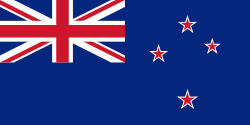Aoraki / Mount Cook (Aoraki/Mount Cook)
Aoraki / Mount Cook is the highest mountain in New Zealand. Its height,, is listed as 3724 m. It sits in the Southern Alps, the mountain range that runs the length of the South Island. A popular tourist destination, it is also a favourite challenge for mountain climbers. Aoraki / Mount Cook consists of three summits: from south to north, the Low Peak (3593 m), the Middle Peak (3717 m) and the High Peak. The summits lie slightly south and east of the main divide of the Southern Alps, with the Tasman Glacier to the east and the Hooker Glacier to the southwest.
The mountain is in the Aoraki / Mount Cook National Park, in the Canterbury Region. The park was established in 1953 and along with Westland National Park, Mount Aspiring National Park and Fiordland National Park forms one of the UNESCO World Heritage Sites. The park contains more than 140 peaks standing over 2000 m and 72 named glaciers, which cover 40 percent of its 700 km2.
The peak is located at the northern end of the Mount Cook Range, where it meets with the main spine of the Main Divide, forming a massif between the Hooker Valley to the southwest and the Tasman Valley east of the mountain. These two valleys provide the closest easily accessible view points of Aoraki / Mount Cook. A lookout point at the end of the Hooker Valley Track located only 10 km from the peak has views of the entire mountainside.
The settlement of Mount Cook Village, also referred to as "Aoraki / Mount Cook", is a tourist centre and base camp for the mountain. It is 7 km from the end of the Tasman Glacier and 15 km south of Aoraki / Mount Cook's summit.
On clear days, Aoraki / Mount Cook is visible from the West Coast as far north as Greymouth, some 150 kilometres away, and from most of State Highway 80 along Lake Pukaki and State Highway 6 south of Lake Pukaki. The near horizontal ridge connecting the mountain's three summits forms a distinctive blocky shape when viewed from an eastern or western direction. Another popular view point is from Lake Matheson on the West Coast, described as the "view of views", where on calm days, the peaks of Aoraki / Mount Cook and Mt Tasman are reflected in Lake Matheson.
The mountain is in the Aoraki / Mount Cook National Park, in the Canterbury Region. The park was established in 1953 and along with Westland National Park, Mount Aspiring National Park and Fiordland National Park forms one of the UNESCO World Heritage Sites. The park contains more than 140 peaks standing over 2000 m and 72 named glaciers, which cover 40 percent of its 700 km2.
The peak is located at the northern end of the Mount Cook Range, where it meets with the main spine of the Main Divide, forming a massif between the Hooker Valley to the southwest and the Tasman Valley east of the mountain. These two valleys provide the closest easily accessible view points of Aoraki / Mount Cook. A lookout point at the end of the Hooker Valley Track located only 10 km from the peak has views of the entire mountainside.
The settlement of Mount Cook Village, also referred to as "Aoraki / Mount Cook", is a tourist centre and base camp for the mountain. It is 7 km from the end of the Tasman Glacier and 15 km south of Aoraki / Mount Cook's summit.
On clear days, Aoraki / Mount Cook is visible from the West Coast as far north as Greymouth, some 150 kilometres away, and from most of State Highway 80 along Lake Pukaki and State Highway 6 south of Lake Pukaki. The near horizontal ridge connecting the mountain's three summits forms a distinctive blocky shape when viewed from an eastern or western direction. Another popular view point is from Lake Matheson on the West Coast, described as the "view of views", where on calm days, the peaks of Aoraki / Mount Cook and Mt Tasman are reflected in Lake Matheson.
Map - Aoraki / Mount Cook (Aoraki/Mount Cook)
Map
Country - New_Zealand
 |
 |
| Flag of New Zealand | |
The islands of New Zealand were the last large habitable land to be settled by humans. Between about 1280 and 1350, Polynesians began to settle in the islands and then developed a distinctive Māori culture. In 1642, the Dutch explorer Abel Tasman became the first European to sight and record New Zealand. In 1840, representatives of the United Kingdom and Māori chiefs signed the Treaty of Waitangi, which in its English version declared British sovereignty over the islands. In 1841, New Zealand became a colony within the British Empire. Subsequently, a series of conflicts between the colonial government and Māori tribes resulted in the alienation and confiscation of large amounts of Māori land. New Zealand became a dominion in 1907; it gained full statutory independence in 1947, retaining the monarch as head of state. Today, the majority of New Zealand's population of 5.1 million is of European descent; the indigenous Māori are the largest minority, followed by Asians and Pacific Islanders. Reflecting this, New Zealand's culture is mainly derived from Māori and early British settlers, with recent broadening of culture arising from increased immigration. The official languages are English, Māori, and New Zealand Sign Language, with the local dialect of English being dominant.
Currency / Language
| ISO | Currency | Symbol | Significant figures |
|---|---|---|---|
| NZD | New Zealand dollar | $ | 2 |
| ISO | Language |
|---|---|
| EN | English language |















